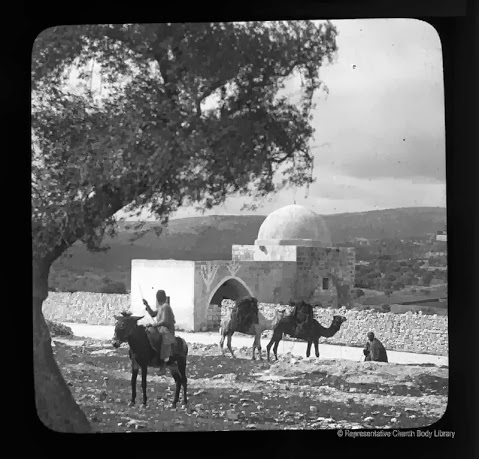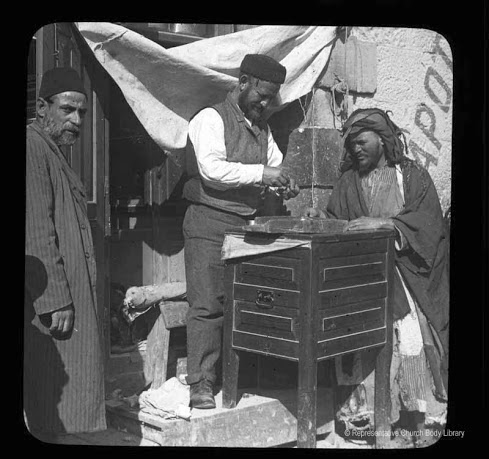|
Posted: 03 Jan 2016
The German Emperor's arrival in Jerusalem on October 28, 1898 was a major news item around the world. The Ottoman rulers of Jerusalem and Palestine changed the face of Jerusalem to receive him. Victory arches were built along his route, and the Old City wall was breached to allow passage of his carriage. And as the picture above shows, one shopkeeper closed his shutters. Why?
Below is the full Library of Congress picture of Jaffa Gate with the following caption: "Photograph taken before October 1898 visit of Kaiser Wilhelm II to Jerusalem when a breach was made in the wall near the Jaffa Gate. (Source: L. Ben-David, Israel's History - A picture a day.)" |
Showing posts with label German emperor. Show all posts
Showing posts with label German emperor. Show all posts
Monday, January 4, 2016
Israel's History - a Picture a Day (Beta) Why the Jerusalem Merchant Closed His Shop when the Emperor Came in 1898
Saturday, January 2, 2016
Israel's History - a Picture a Day - Ottoman Rabbis and the Jerusalem Store that Boycotted the German Emperor
Israel's History - a Picture a Day (Beta) |
Sunday, April 13, 2014
Jerusalem on Passover, 1928
Israel's History - a Picture a Day (Beta) |
|
Posted: 12 Apr 2014
No other information is provided, but we can deduce quite a bit. The picture above shows the Chief Rabbi of Palestine, Abraham Isaac Kook, delivering a Torah discourse to a large audience. Where? Quite possibly near his home between Jerusalem's Prophets Street and Jaffa Road. While women are sitting separately from the men, the audience is most certainly not an ultra-Orthodox crowd. With their heads covered, they are more likely a religious Zionist grouping. Their holiday dress suggest that it either the Passover holiday or the Sabbath of Passover.
The next picture shows the pilgrims' destination -- the Western Wall in Jerusalem's Old City. The crowd entered the Old City through Jaffa Gate and is streaming into the shuk at the end of David Street on the way to the Kotel. The Thomas Cook travel office was a prominent landmark already prior to 1898 and could be seen in the last picture on this page.
|
Wednesday, December 11, 2013
The Church of Ireland Library's 115-Year-Old Photographic Treasure - photos of Jerusalem
Israel's History - a Picture a Day (Beta) |
|
Posted: 11 Dec 2013
The Church of Ireland's Representative Church Body Library's full collection can be viewed HERE. The photos here are presented with the permission of the RCB Library. Click on pictures to enlarge; click on the captions to view the original photo. Subscribe to receive www.israeldailypicture.com in your email by entering your address in the right sidebar.
|
Tuesday, May 28, 2013
The New Old Train Station in Jerusalem
The New Old Train Station in Jerusalem

Welcoming party at the Jerusalem train station (Library of Congress, date given as 1898-1946)
A new cultural and entertainment center just opened in Jerusalem and it's called the "First Station." With a farmers' market, restaurants, crafts stores and a children's play center, the First Station promises to be a busy hub for Jerusalem activity.
Just like it was when it first opened in 1892, more than 120 years ago, when the first train from Jaffa pulled into Jerusalem's new train station.
Open seven days a week, the new attraction presents a different fair every day. View the First Station's website here.
The Jerusalem train station has been a frequent feature of the Israel Daily Picture, with pictures of the arrival of the German emperor in 1898 and the transfer of a high-ranking British prisoner of war, Col. Coventry in 1916, captured in Sinai during World War I.

British POW Col. Coventry driven from railroad station
by Turkish army (1916)

The German emperor arrives (1898)

Railroad station (circa 1910)

Another view of station (1900)
The mystery picture above of a dignitary's arrival is dated by the Library of Congress as between 1898 and 1946, the years the American Colony photographers were active in Palestine. But numerous clues helps to pin down the dates.

Enlarged poster

Why is an antelope among the soldiers?

Welcoming party at the Jerusalem train station (Library of Congress, date given as 1898-1946)
A new cultural and entertainment center just opened in Jerusalem and it's called the "First Station." With a farmers' market, restaurants, crafts stores and a children's play center, the First Station promises to be a busy hub for Jerusalem activity.
Just like it was when it first opened in 1892, more than 120 years ago, when the first train from Jaffa pulled into Jerusalem's new train station.
Open seven days a week, the new attraction presents a different fair every day. View the First Station's website here.
The Jerusalem train station has been a frequent feature of the Israel Daily Picture, with pictures of the arrival of the German emperor in 1898 and the transfer of a high-ranking British prisoner of war, Col. Coventry in 1916, captured in Sinai during World War I.

British POW Col. Coventry driven from railroad station
by Turkish army (1916)

The German emperor arrives (1898)

Railroad station (circa 1910)

Another view of station (1900)
The mystery picture above of a dignitary's arrival is dated by the Library of Congress as between 1898 and 1946, the years the American Colony photographers were active in Palestine. But numerous clues helps to pin down the dates.

Enlarged poster

Why is an antelope among the soldiers?
The railroad to Jerusalem was halted during World War I and not reopened until October 1920, so the arrival ceremony with a British honor guard could not have taken place before that date.
Posters on the station wall advertise the White Star Cruise Line that ceased operation in 1936 when it was taken over by the Cunard Line. We can date the picture between 1920 and 1936.
There's also one more curious feature seen when the photo is enlarged. Among the rifles and bayonets on the right of the photo appear two animal horns sticking up. The decorated horns belong to "Bobby," an antelope, the regimental mascot of the Royal Regiment of Fusiliers.
According to the Fusiliers Association of Great Britain, "The mascot was looked after by two handlers chosen from the battalion, they would make sure that he was fed and watered and exercised. When on parade they kept him under control by means of two white ropes attached to his collar which was also white, and was emblazoned with a large silver badge. On his back he wore a coat of royal blue, embroidered with the regimental crest, and his horns were tipped with silver cones."
Posted by Our Mission at 7:57 AM
Email ThisBlogThis!Share to TwitterShare to Facebook
Labels: antelope, Colonel Coventry, German Emperor, Jerusalem, Railroad, Royal Fusiliers, train station, White Star cruise line
Posters on the station wall advertise the White Star Cruise Line that ceased operation in 1936 when it was taken over by the Cunard Line. We can date the picture between 1920 and 1936.
There's also one more curious feature seen when the photo is enlarged. Among the rifles and bayonets on the right of the photo appear two animal horns sticking up. The decorated horns belong to "Bobby," an antelope, the regimental mascot of the Royal Regiment of Fusiliers.
According to the Fusiliers Association of Great Britain, "The mascot was looked after by two handlers chosen from the battalion, they would make sure that he was fed and watered and exercised. When on parade they kept him under control by means of two white ropes attached to his collar which was also white, and was emblazoned with a large silver badge. On his back he wore a coat of royal blue, embroidered with the regimental crest, and his horns were tipped with silver cones."
Posted by Our Mission at 7:57 AM
Email ThisBlogThis!Share to TwitterShare to Facebook
Labels: antelope, Colonel Coventry, German Emperor, Jerusalem, Railroad, Royal Fusiliers, train station, White Star cruise line
Subscribe to:
Posts (Atom)

















